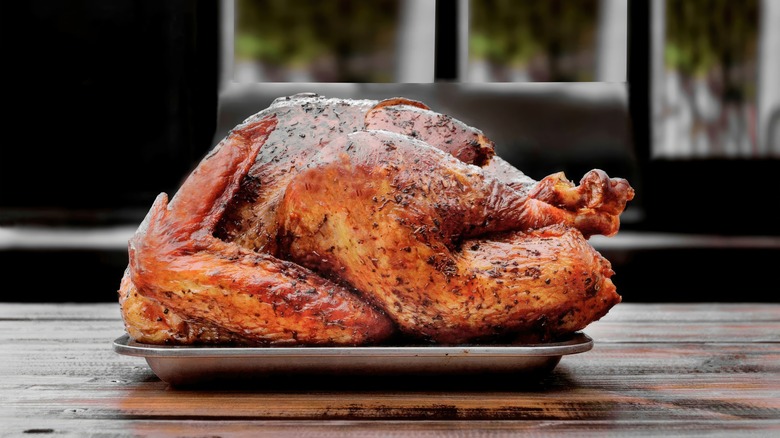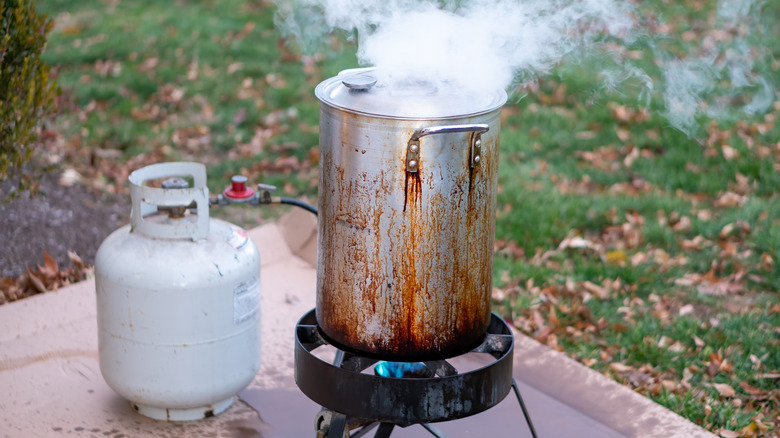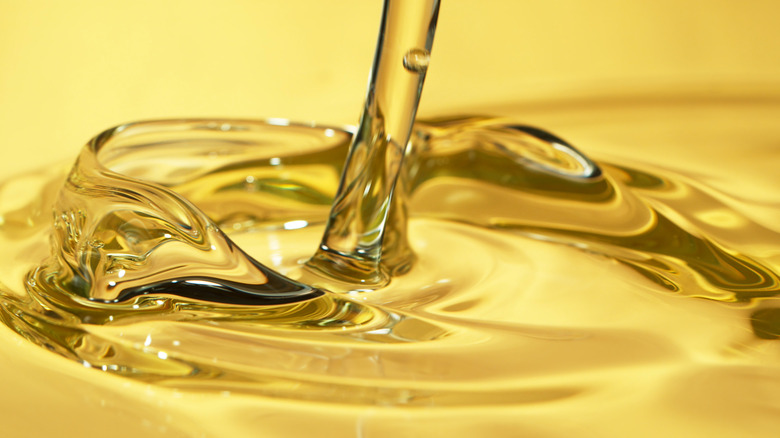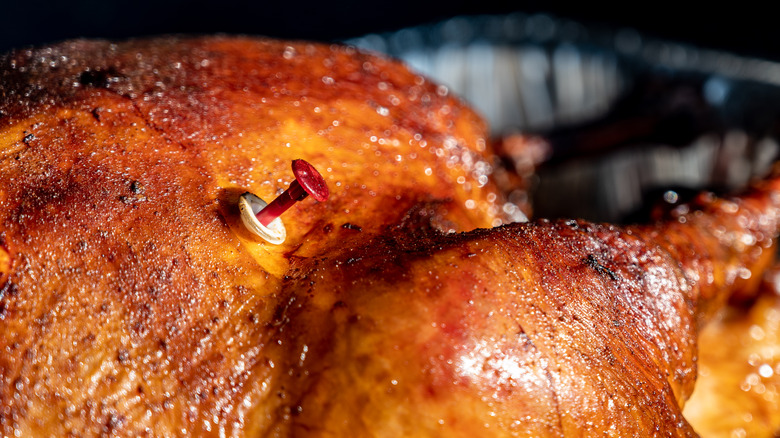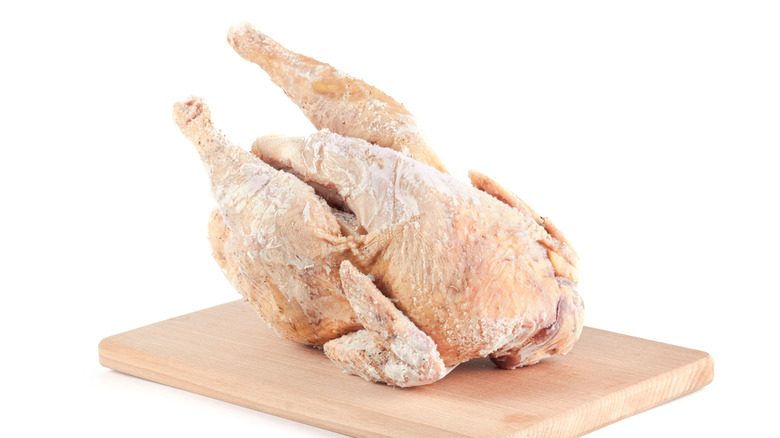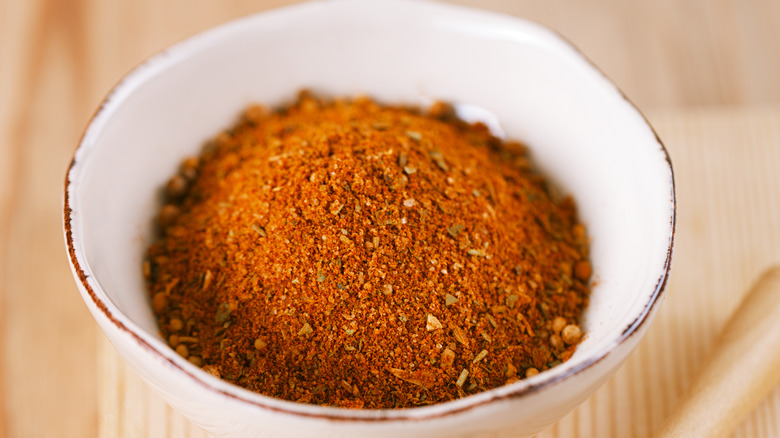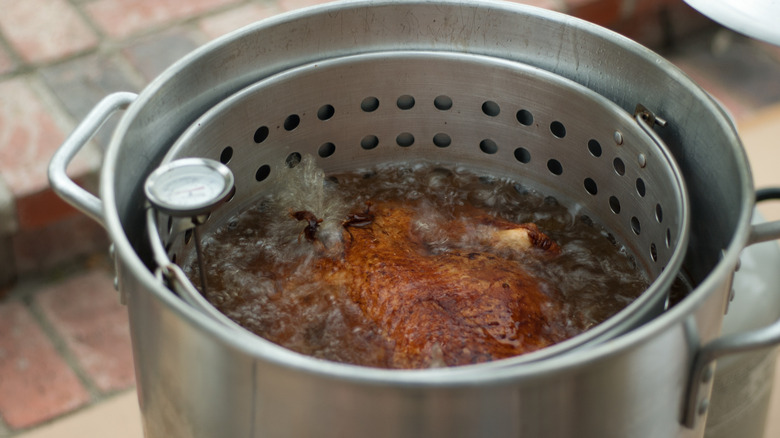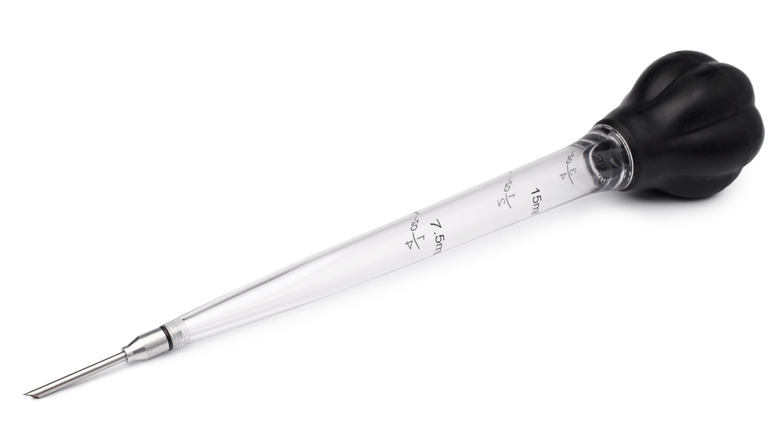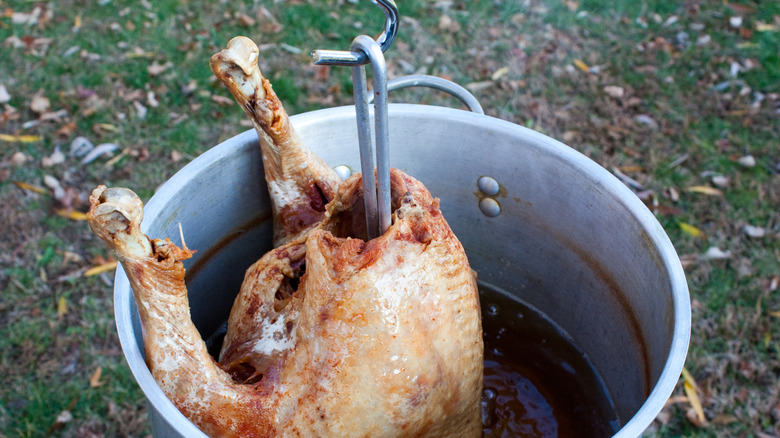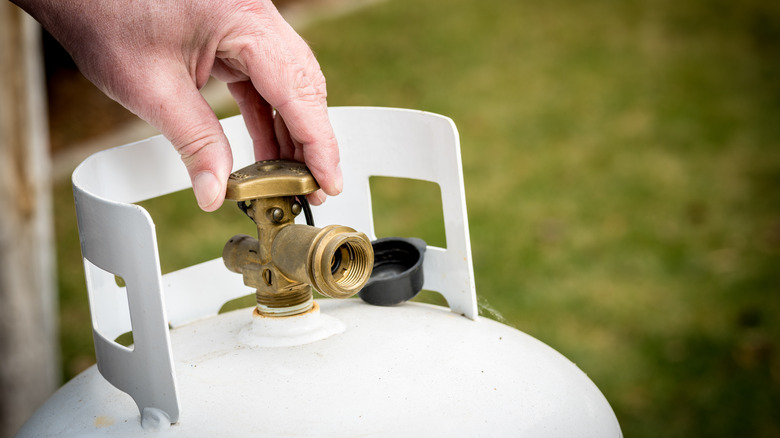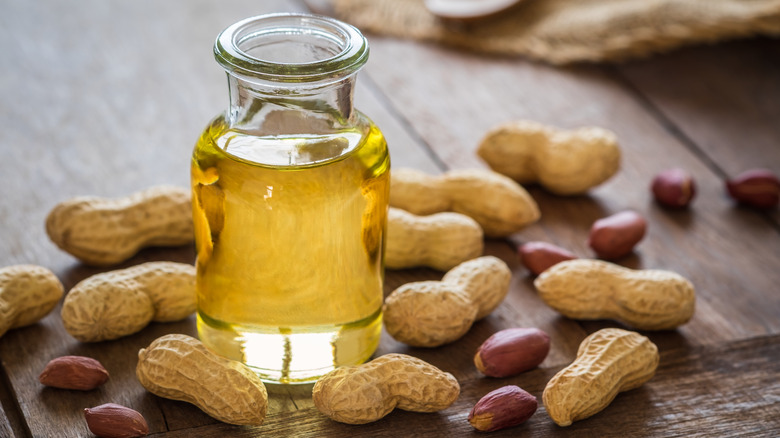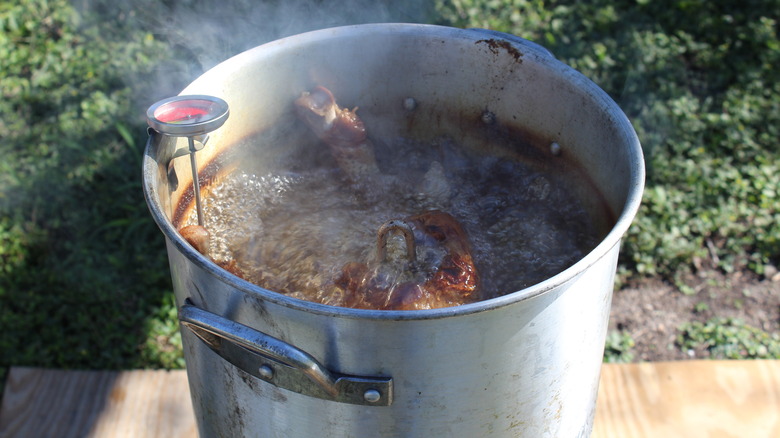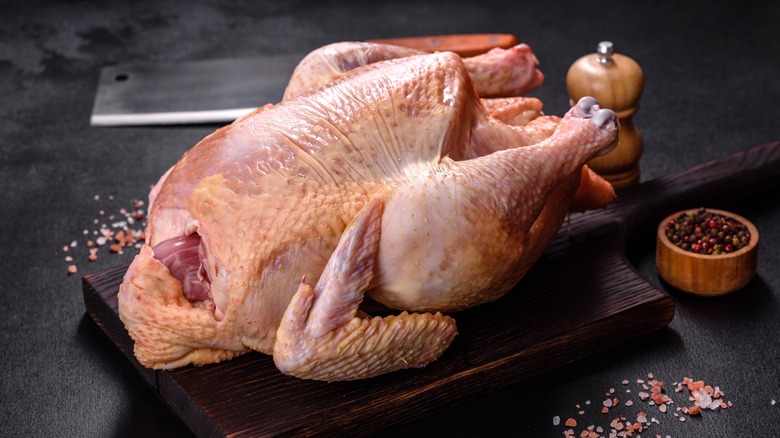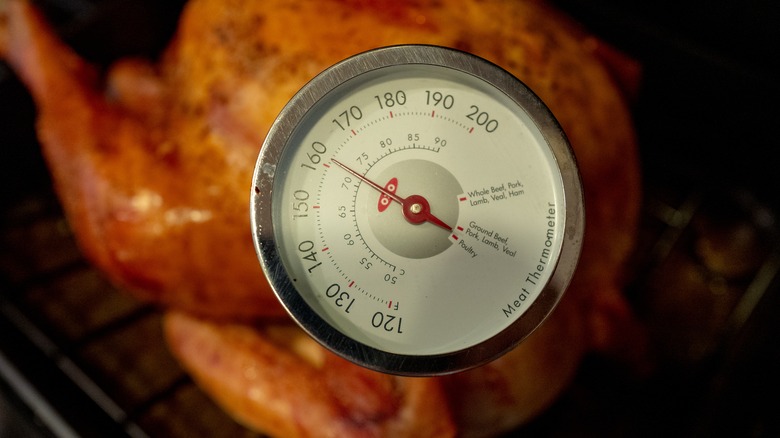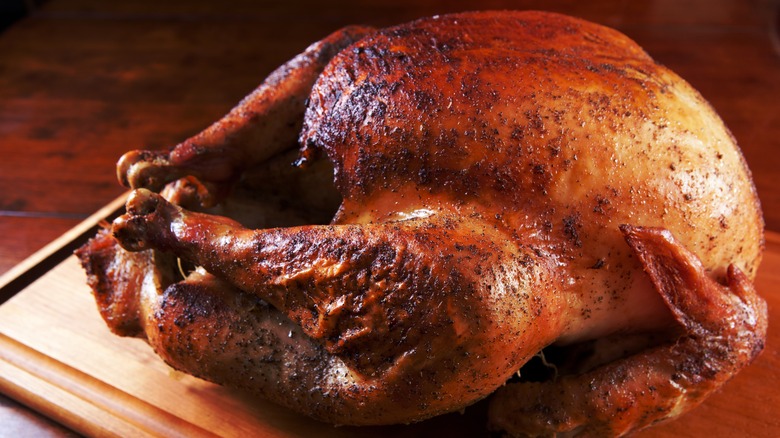14 Expert Tips You Need When Deep-Frying A Turkey
Cooking a turkey is a way more versatile process than you might think. While most people roast their turkeys, with the big bird best suited to be prepared in the slow, continuous heat of the oven, ensuring that it cooks through properly, turkeys can also be smoked, air-fried, and arguably most famously, deep-fried. The modern tradition of deep-frying a turkey for Thanksgiving started in the late 1970s in Louisiana, with the pots used to cook crawfish repurposed by people seeking an alternative method of preparing their festive bird. What was once a purely Southern practice, though, has since spread across the country.
Deep-frying a whole turkey may seem extravagant, but doing it brings certain culinary advantages. Submerging the turkey in oil keeps the meat moist and tender, locking in its natural juices, which can be quickly lost when it's roasted. Deep-frying also gives your turkey a deep brown color and a crispy skin, creating a bird that's as aesthetically pleasing as it is delicious. However, it's understandable that if you haven't deep-fried a turkey before, you may have a few questions about how to do it right. So that's why we turned to the experts. We sourced some of our favorite tips from professional chefs to talk you through how to prep your turkey correctly, fry the bird while remaining safe, and stop it from becoming too greasy.
1. Assemble your equipment beforehand
When deep-frying a turkey, preparation is key — and before you begin, you'll need to make sure you have all the right equipment. Unlike other methods of cooking turkey, deep-frying requires several specialist items, most of which are needed to make sure you stay safe and well-protected.
To heat and cook your turkey, you'll need a propane burner and a large turkey fryer, advises Chef Barbara Alexander. This turkey fryer should have a stand that's sturdy and well-constructed to reduce the risk of things toppling over while you cook. Ensure that your stand is on a completely flat surface, with plenty of space around and underneath it. The latter is important so that the burner can fit under it.
As well as this, you'll also need a thermometer to test the temperature of your oil, a poultry rack or hook for your turkey to rest on, and a pair of burn-proof oven mitts. If possible, these mitts should go up the length of your arm to protect you from any oil splashes. You'll also need a draining rack or somewhere to place your turkey once you pull it out. Finally, you'll need a large amount of your chosen oil and, of course, your turkey and the seasonings for it.
2. Test the amount of oil you'll need first
You'll need a lot of oil to deep-fry a turkey — most likely way more than you think. If you don't put enough oil in your pot, you run the risk of your turkey not being completely submerged, which will prevent it from cooking evenly and leave part of it raw. There's always the risk, though, of using too much oil. If you put too much in, it can take too long to heat up to the right temperature, and there's a chance that hot oil will bubble over and splash out when you put the turkey in.
You can avoid both of these scenarios and ensure you have just the right amount of oil with a tip from Alton Brown. Before you do anything, place your turkey into your pot and measure out a gallon of water. Pour the water over the turkey, seeing how far up it comes on the bird. Refill your jug and repeat until the bird is completely covered. "That way, [you'll] know how much oil to place in there, and [you'll] also make sure that the pot is large enough for the job," Brown says on YouTube. Write down the amount it takes, and when it comes to cooking the bird, simply add the same amount of oil.
3. Ensure you're removing the thermometer
Many turkeys are sold with a thermometer inserted into the breast. These plastic contraptions are designed to pop up when the turkey has reached the correct internal temperature to avoid pulling the bird out of the oven when it's still underdone. But while these can be useful when roasting your turkey, they're less useful when deep-frying it. "Pull out the thermometer, because you don't want any plastic pieces going into the hot oil," states chef Jess Roy on YouTube. If the plastic comes into contact with the oil, it runs the risk of melting, making it impossible to remove and potentially releasing unpleasant tastes and toxic carcinogens into your food, according to the Plastic Soup Foundation.
Roy also advises that you should remove any plastic trussing that the turkey comes with for the same reason. You should also pull the neck and giblets out of the inside of your turkey. Leaving these in will stop the oil from getting into the bird properly, meaning it won't cook as well on the inside. Save your neck and giblets for homemade turkey gravy, which they'll both add deep, savory flavor to.
4. Thaw your turkey ahead of time
While you can theoretically cook a turkey from frozen, doing so can be a slightly risky move, as you risk the meat not cooking through properly. But frozen turkey can be dangerous when deep frying it for entirely different reasons. "If you try to put any part of a frozen turkey into hot frying oil, it's going to create a turkey bomb. That is a sure way to ruin your Thanksgiving," warns chef Jess Roy on YouTube.
If you place a frozen turkey into hot oil, it creates a scenario where some of the ice is turning to steam pretty much instantly. As the turkey continues to lower into the oil, steam forms at the bottom of the pot, forcing the boiling oil out of it. The oil can then fall onto the propane burner, which can, in the worst-case scenario, cause a life-threatening explosion, according to Forbes.
This is why it's important to ensure your turkey is completely thawed before cooking it. Always defrost your turkey in the refrigerator to control its temperature as it thaws. Remember that thawing a turkey can take way longer than you think. As each three to four pounds of turkey can take roughly a day in the refrigerator to defrost, you may need several days to ensure it's totally safe to cook.
5. Marinade your turkey in advance
Turkey is renowned for having a neutral, subtle flavor, and in the wrong hands, this can sometimes leave it pretty tasteless. And while deep frying your turkey is a great way to lock in moisture and add flavor from the fat and oil, you'll still need to season it to get the best results. One of the easiest ways to imbue a deep-fried turkey with flavor that permeates its meat is to give it a dry marinade, as chef Rina Prentice recommends.
Pat your turkey dry to remove any excess moisture, and then grind together bay leaves, dried oregano and thyme, garlic powder, hot Creole seasoning, and black peppercorns. Then, rub this dry marinade onto the outside of your turkey and into its center, making sure to get a good amount under the skin, too. The combination of spices and aromatic herbs will give your turkey a Southern flavor, which is appropriate given its Louisianan roots. These seasonings will activate in the hot oil, giving the turkey a smokey, complex taste. Just make sure you're not only rubbing it on the outside of your turkey, as some of the seasoning may come off in the oil, wasting all your hard work.
6. Keep an eye on your temperature
When it comes to deep-frying a turkey, temperature is everything. And while you want things to be hot, it's important not to go too far. Overheating your oil will create two issues: It'll burn your turkey as well as the fat. If the oil is too hot, the turkey will brown excessively on the outside but won't cook through to the middle adequately, leaving parts of the meat raw. Burning your oil, meanwhile, will cause it to smoke — and as you're using a lot of it, this could create a significant stench.
That's why chef Jess Roy recommends deep-frying your turkey at an even 350 degrees Fahrenheit. Alton Brown, meanwhile, advises going for the 375-degree mark. A little leeway here is fine; ensure that you're not going too high above this or too low. To check your oil's temperature, go for a clip-on deep-fry thermometer, which you can attach to the side of your pot before cooking. Before you start frying, make sure to test your propane burner to assess whether the flame is burning consistently so you're not left with a sudden drop in temperature.
7. For added flavor, inject your turkey
Figuring out how to get flavor into a turkey is an age-old question, and for some reason, it can feel harder when deep-frying. But it needn't be. Instead of basting your turkey to add flavor, as you would when roasting it, you can insert seasonings directly into your bird by injecting it with a premade dressing blend, a technique championed by chef John Folse.
Take any dried herbs or spices you wish to use to flavor your turkey and place them in a food processor with some bottled Italian dressing. Whizz them together to ensure that your dried seasonings are well incorporated with the dressing, and then pour the mixture into a poultry injector. Inject your turkey all over its body before placing it in the deep-fryer as normal.
This technique will give your turkey pockets of punchy flavor and will also serve to moisten the bird from the inside. The best part is that you can add any flavoring you like into the mix. If you prefer a savory bird, try putting in a few dashes of Worcestershire sauce and some onion powder. Spice lovers might prefer a shake or two of ultra-fiery hot sauce. Whatever you add, make sure your mixture isn't too watery, as it runs the risk of turning into steam in the hot oil and ripping the flesh of the bird.
8. Hook your turkey properly
Arguably, the scariest part of making a deep-fried turkey is getting it in and out of the oil without it spilling everywhere. To do this, you'll need a hook and a poultry rack. Once your turkey is ready to cook, place it on the rack with the hook attachment poking out of its interior and facing upward. You then need to use the hook to pick it up and slowly lower it into the oil.
Doing this allows you to get the turkey into the hot fat without coming anywhere near it and lets you fish out the turkey when it's done without having to worry about contact with the oil. Additionally, you should also make sure your turkey is trussed properly so that you're not left with any parts poking it, which may get in the way of lowering and retrieving it. Use a piece of steel wire, as Martha Stewart does, to stop the trussing from melting or burning in the fat. Wind it around the legs and the parson's nose, and then tuck in your wing tips. Trussing your turkey properly will also stop the more exposed parts from drying out or burning as it cooks.
9. Protect your propane tank
Deep-frying a turkey involves cooking with propane, which can be pretty intimidating for folks who aren't used to doing this. And we can see why. Around 3,000 explosions or infernos caused by propane are reported every year, with a large proportion of these resulting in injury or death, according to research published in the Journal of Burn Care and Rehabilitation. As well as being explosive, propane can also be toxic to inhale and may cause serious damage or injury when doing so, warns Chemscape.
As such, it's incredibly important to ensure that your propane tank is properly operational before use and that any connections between parts are secure. Conducting a leak check by applying a leak detector solution and checking for bubbles is a good idea. When you're cooking, too, you should protect both the tank and the pipe used to deliver the fuel, as Alton Brown suggests. You can do this by wrapping the outside of your rubber pipe in a heavy casing of tin foil. This will create a barrier around the pipe and may protect it from any oil splashes that spill out of the pot.
10. Ensure that you're using the right oil
You're going to need a lot of oil to deep-fry a turkey, so it's wise to pick the right one. The most crucial factor to consider is the smoke point. Some oils are way more resistant to heat than others, but all of them have a temperature at which they start to break down and release smoke. This won't just make you unpopular with your neighbors, as plumes of smoke waft over their backyards; it will also make your turkey taste terrible, giving it a burnt flavor.
Chef Rina Prentice recommends using peanut oil to deep-fry a turkey, thanks to its high smoke point and stability. When peanut oil is refined, it's tasteless, so there's no need to worry about it giving your turkey a nutty edge. Meanwhile, its ultra-high smoke point of 440 to 450 degrees Fahrenheit means that even if you overheat the oil, it'll remain usable. Standard vegetable oil and canola oil are also both stable at high temperatures and have very little flavor, and will be perfectly fine to use if you're cooking your turkey at 350 degrees Fahrenheit.
11. Time it correctly
Deep-frying food can feel, in some ways, somewhat easier than regular frying. Not only does deep frying give your food all-over color and crunch while locking in juiciness, but it can also be harder to scorch food in the same way that you would on a hot frying pan. But deep-fried foods can still burn — and when you're dealing with a food item as large, important, and expensive as a turkey, this is something you want to avoid. Deep-fried turkeys can also become dry and tough if you overcook them, ruining the centerpiece of your meal.
So, make sure you nail your timings. Chef Barbara Alexander recommends cooking your turkey for around three to four minutes per pound if you're cooking at 375 degrees Fahrenheit. For a 15-pound bird, this can mean that it takes roughly 45 minutes to cook through entirely. If you're forgetful, set yourself a kitchen timer so you don't forget to take it out once it's done — remember, it can be hard to see the doneness of the bird once it's in the oil. You should also never be tempted to walk away from the bird while it's cooking, no matter how long it takes. Doing so can be incredibly risky, and you run the risk of oil spillages or hazards caused by the open propane flame, warns Public Safety Fitchburg, Wisconsin.
12. Leave your turkey unstuffed
Everyone loves stuffing with their turkey. But when deep-frying your bird, placing any stuffing — or anything at all — inside is a big no-no. "Never stuff the turkey when you're gonna fry it, because that oil has to get on the inside as well as the outside," as explained on Martha Stewart by the chef herself. The oil being able to circulate on the inside of the bird helps to cook it from the inside and also seals its juices in from another angle, ensuring that the meat remains moist.
If you put stuffing inside, the oil will just cook that — and it also may dislodge the stuffing, causing it to float around in the boiling fat. Placing stuffing inside a bird and then deep-frying it will also prolong the time it takes to cook, meaning that you may dry out your turkey or leave it uncooked in certain places.
Instead, your bird's cavity should remain open and empty, with only a little seasoning for flavor inside. Focus on cooking your stuffing separately, in its own baking dish, before serving it alongside the bird. Try sprinkling some Cajun seasoning into your regular recipe to make the best Southern turkey stuffing to accompany your meat.
13. To test doneness, a meat thermometer is essential
No one wants an underdone turkey on the kitchen table. And if you're new to deep-frying turkey, it can seem trickier to assess exactly when it's done. In reality, however, checking whether a deep-fried turkey has cooked through is exactly the same as checking a turkey prepared by any other method, and all it takes is a meat thermometer.
After you pull your turkey out of the oil, taking care to do so, take your meat thermometer and insert it directly into the thigh, as chef Jess Roy does. "It's the thickest part of the bird, so therefore, when it's done, I know the turkey's done," she says on YouTube. Roy looks for an internal reading of 150 degrees Fahrenheit to indicate that the turkey is cooked through.
Other chefs, like chef Barbara Alexander, advise that you should try to reach an internal temperature of 165 degrees Fahrenheit before allowing it to rest out of the oil. It's worth pointing out that 165 degrees is the temperature advised by the FDA as a safe minimum for poultry products to make sure they carry no risk of foodborne illness. If you're worried about getting sick, we would advise going for the higher temperature.
14. Drain and rest your turkey before serving
All turkeys need rest once they've been cooked, but deep-fried turkeys require another step: draining. When you pull the turkey out of the hot oil, it will be covered with cooking fat and incredibly hot. If you try to serve it straight away, you'll leave your guests with a super-greasy meal that'll scald their mouths, and most of its internal juices drain away when you carve it.
Instead, give your turkey around 15 to 20 minutes to drain. Martha Stewart recommends placing your turkey in a large pan with a perforated insert so the excess fat can drip off the bird and into the bottom. If you don't have one of these, you can place it on a wire rack propped above a pan.
You can always use the fat that drains off the turkey to make your gravy but bear in mind that it likely won't be as flavorful as the drippings you'd get in the bottom of a roasting dish. If you'd like to remove the excess fat even more, pat the outside of your turkey gently with a paper towel, but bear in mind that you may remove some of the seasonings you've added.
